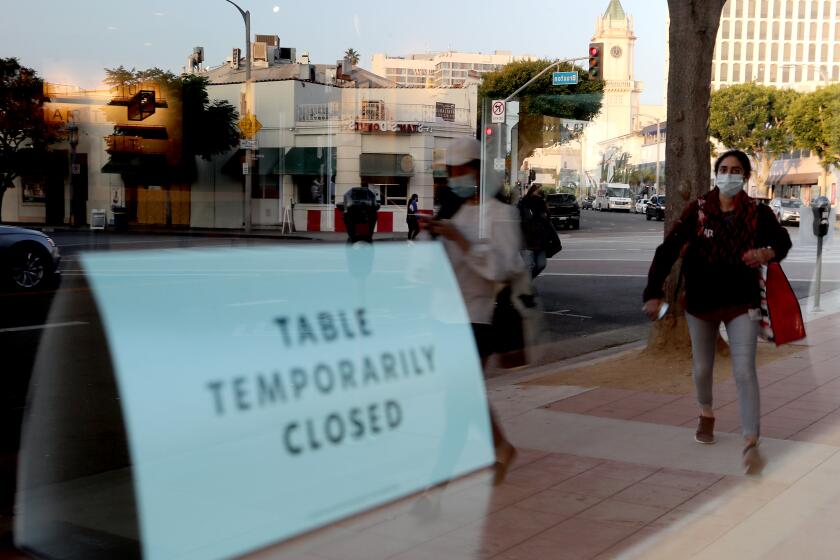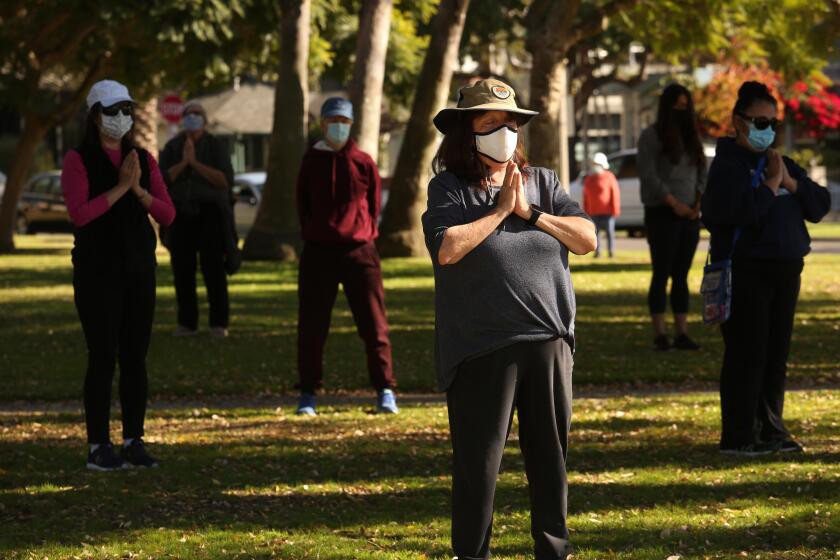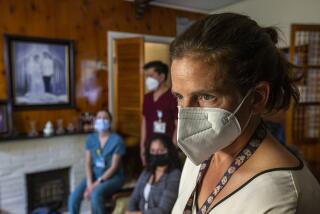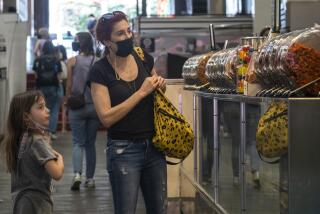L.A. County’s new stay-home order is the strictest in California. Here’s how it works
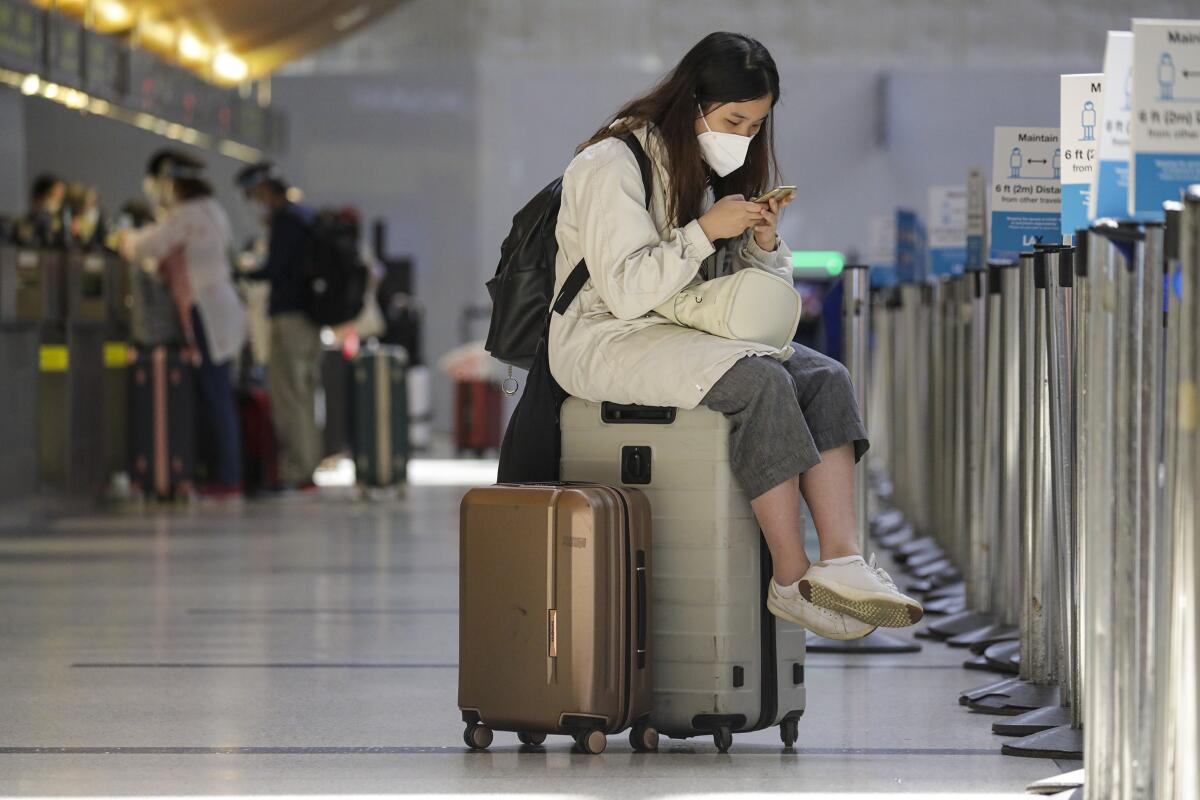
Los Angeles County has issued a new COVID-19 pandemic order that prohibits most gatherings and discourages most crowds, the latest in a series of desperate moves aimed at slowing an unprecedented surge of coronavirus infections.
How does it work?
It’s certainly not as severe as the stay-at-home order issued in March. But it does mean that most gatherings — apart from outdoor church services and outdoor political protests — were banned starting Monday morning, with the order set to last for the next three weeks, until Dec. 20. Still, it is the strictest currently in California, a sign of how serious conditions are in L.A. County.
Retail stores will remain open, albeit at a more limited capacity.
The new order comes as L.A. County faces its worst crisis of the pandemic. In recent weeks, the number of new daily coronavirus cases has quadrupled, while hospitalizations and daily deaths have tripled. Officials have warned that unless transmission rates drop substantially, L.A. County is on track to run short of hospital beds within two to four weeks.
L.A. Mayor Eric Garcetti didn’t order the recent county ban on outdoor dining, but he’s still facing pressure from restaurant owners who are frustrated with his messaging.
The latest surge began to be detected in late October, and began accelerating in November.
Here’s a summary of the changes:
Ban on gatherings, except for worship and political protests
For the first time since early October, most gatherings among people from different households in L.A. County are again officially prohibited, with the exception of outdoor religious gatherings and outdoor political protests.
This supersedes the previous rule that allowed for only small, outdoor gatherings of 15 or fewer people from up to three different households, for a duration of no more than two hours.
The new rules, affecting stores, playgrounds and gatherings, are less severe than the stay-at-home order initiated in the spring.
Retail limits on capacity
Essential retail stores are limited to 35% of capacity; for grocery stores, that was a reduction from the current cap of 50% capacity.
Nonessential retail stores, malls, libraries and personal care establishments such as hair salons, barbershops, nail salons, piercing shops, tanning services and massage therapy are limited to 20% of capacity; previously, they operated at 25% of capacity.
Outdoor museums and zoos at half capacity
A 50% capacity limit applies to outdoor museums, galleries, zoos and aquariums. Previous rules allowed as many patrons as could be accommodated while maintaining six feet of distance from people from other households.
Outdoor gym and mini-golf, batting cages, and go-kart racing establishment capacity remained unchanged at 50% of maximum capacity.
Playgrounds must shut except those at schools and child-care centers
Playgrounds that are not part of a school or child-care center must close under the new order.
Cardrooms must shut
Outdoor cardrooms, which under existing rules have been able to operate, were ordered to close.
Outdoor recreation spaces remain open
Beaches, trails and parks remain open, as do golf courses, tennis courts, pickleball courts, archery ranges, skate parks, bike parks and community gardens. Visitors must wear masks and stay at least six feet away from people from other households.
Outdoor swimming pools that serve more than one household are restricted to regulated lap swimming with one person per lane.
Schools and child care rules largely left unchanged
Child care centers, schools and day camps that have remained open under current protocols can continue operating with one new requirement: mandatory closure for 14 days should an outbreak occur, which is defined as three or more cases over a two-week period.
Orders that haven’t changed
- Restaurants in most of L.A. County can now offer only takeout and pickup service; outdoor dining areas were ordered shut Wednesday night, except within the city of Pasadena, which has its own independent public health department.
- The state has issued a limited overnight stay-at-home order, which forbids nonessential activities outside the home with members of other households between 10 p.m. and 5 a.m.
Pasadena weighs new restrictions
Pasadena has stepped up enforcement of coronavirus rules and may consider new restrictions. Compliance has been mixed: Health inspectors conducted about 60 site visits Wednesday and Thursday, and the majority of restaurants — more than 40 — were violating the rules, a city spokeswoman, Lisa Derderian, said.
“The most common violations included no face shields, tables not properly distanced and enclosed dining areas,” she said.
Virus now more widespread
The virus is now far more widespread in Los Angeles County than at any point since the surge of the early summer, with one out of every 145 people now currently infectious, according to county estimates. “If people do participate in gatherings, it can be quite dangerous,” warned Dr. Christina Ghaly, the county director of health services, last week. “Much of the COVID-19 transmission occurs before any symptoms occur” among the infected persons.
County Supervisor Hilda Solis said in a statement that she supported the new health order. Previous orders issued in the spring and summer have been successful in reducing transmission.
“When the case rate reaches a certain point, it takes drastic measures to slow down the spread of this tremendously deadly virus,” said Solis, whose district includes East L.A., southeast L.A. County and the San Gabriel Valley. “We must keep ourselves and our families safe so that we can avoid getting sick and adding even more burden to our already overwhelmed healthcare system.”
Tougher stay-at-home order may be needed
Los Angeles County officials warned that a tougher stay-at-home measure will be necessary if cases keep spiking.
“If this doesn’t work, and two to three weeks from now we find ourselves in a worse place than we are, we’re going to have to go back and look at what else do we have as options, because we cannot continue to risk overwhelming the healthcare system,” said the county director of public health, Barbara Ferrer, on Saturday. “I don’t think there’s any disagreement about that — that’s a disaster that we have to avoid at all costs.”
Strict rules imposed in Santa Clara County
Northern California’s most populous county, Santa Clara County in the Bay Area, on Saturday issued its own set of health orders, effective Monday to last until Dec. 21 unless extended. Santa Clara County is on track to run out of staff hospital bed capacity within weeks if current trends continue; several hospitals already have few, if any, intensive care unit beds available. The new orders include:
- Mandatory quarantine for travelers: Requires anyone coming into Santa Clara County after traveling more than 150 miles to quarantine for 14 days. Those under quarantine should stay home as much as possible and have food delivered to them. Healthcare workers traveling into the county to provide care for patients, or patients traveling into the county to obtain treatment, are exempted.
- Stricter capacity limits for stores: Nonessential retail indoor capacity were limited to 10% of capacity in Santa Clara County; essential stores like supermarkets and pharmacies were capped at 25%. Facilities open to the public must have a “metering system,” like an employee stationed at the entrance, to ensure that stores don’t get crowded beyond the capacity in the new health order.
- Restrictions on sports involving close contact: All contact sports, including all recreational activities that involve close physical contact or close proximity to people outside of your household, were prohibited in Santa Clara County. Outdoor recreation where social distancing can be practiced can continue. The restrictions mean the San Francisco 49ers cannot play host to home games scheduled for Dec. 7 and 13; they play at Levi’s Stadium in Santa Clara.
- Hotels closed to leisure travel: Hotels and other lodging facilities in Santa Clara County are open to only essential travel and people who need to isolate or quarantine themselves due to the coronavirus. Leisure and nonessential travel are strongly discouraged.
- Small outdoor gatherings still allowed: Outdoor gatherings of no more than three households remain allowed. Outdoor gatherings of up to 100 people are allowed for 1st Amendment-protected activities, such as religious services and protests.
Other health officers in the Bay Area expressed support for the stricter rules and said in a statement they “may also have to take similar actions soon in order to preserve remaining regional hospital capacity.”
Here’s a summary of how the state and other counties are faring in Southern California. Some counties have not reported cases or deaths daily due to the Thanksgiving holiday weekend.
Statewide
California has seen daily coronavirus cases quadruple and hospitalizations triple in recent weeks. Daily deaths are up more than 50% in less than a month.
California is now averaging roughly 13,000 cases a day over a seven-day period, and roughly 60 Californians a day are dying on average over the same period.
Los Angeles County
L.A. County is now averaging more than 4,000 new coronavirus cases daily, far worse than the summertime surge when the average daily case rate maxed out at 3,300.
Hospitalizations have risen at an increasingly faster pace for more than two weeks. As of Friday, there were more than 2,000 people in L.A. County’s hospitals with COVID-19 — close to its previous high of more than 2,200 recorded in the summer.
COVID-19 deaths have also started to rise. L.A. County is recording roughly 30 deaths a day over the past seven days, triple the number from early November.
San Diego County
San Diego County’s average new case count has increased more than fivefold and hospitalizations have tripled in recent weeks. California’s second most populous county is now averaging more than 1,300 new cases a day; in early October, that figure was just above 250.
There were nearly 600 with coronavirus infections in San Diego County hospitals on Friday, about triple the number from the end of October.
Orange County
Orange County’s average of new daily coronavirus cases has quadrupled and hospitalizations have doubled in recent weeks.
Orange County is averaging more than 1,000 coronavirus cases a day over a seven-day period; on Nov. 1, just 220 people with positive virus diagnoses were in the hospital.
More than 500 people were in the hospital on Friday; there were fewer than 250 on Nov. 14.
Riverside County
Hospitalizations have quadrupled in Riverside County since the start of October. More than 500 people with coronavirus infections were in the hospital on Friday; on Oct. 1, 130 people were in the hospital.
San Bernardino County
Average new daily coronavirus cases have quadrupled since mid-October in San Bernardino County. More than 1,100 new cases a day were reported on average over a seven-day period as of Saturday; on Oct. 18, the rate was 250 cases a day.
Hospitalizations tripled in the past month; there were 661 people in the hospital with COVID-19 on Friday; on Oct. 26, 217 people were in the hospital. Hospitalizations have now exceeded the summertime peak of 638, recorded in late July.
Ventura County
Hospitalizations have quadrupled since late October. There were 84 people in hospitals with coronavirus infections on Friday; that’s up from 21 on Oct. 25.
Kern County
Hospitalizations have tripled since early November. There were 165 people in hospitals with coronavirus infections on Friday; that’s up from 51 on Nov. 4.
Santa Barbara County
Hospitalizations have tripled since early November. On Friday, there were 33 people in hospitals with coronavirus infections; that’s up from nine people on Nov. 7.
Imperial County
Hospitalizations have more than tripled since late September. On Friday, there were 70 people in hospitals with coronavirus infections; that’s up from 20 on Sept. 27.
Times staff writer Sam Farmer contributed to this report.
More to Read
Sign up for Essential California
The most important California stories and recommendations in your inbox every morning.
You may occasionally receive promotional content from the Los Angeles Times.
